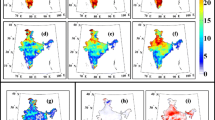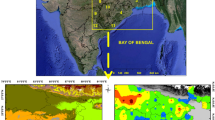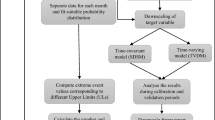Abstract
Indian summer monsoon rainfall extremes and their changing characteristics under global warming have remained a potential area of research and a topic of scientific debate over the last decade. This partially attributes to multiple definitions of extremes reported in the past studies and poor understanding of the changing processes associated with extremes. The later one results into poor simulation of extremes by coarse resolution General Circulation Models under increased greenhouse gas emission which further deteriorates due to inadequate representation of monsoon processes in the models. Here we use transfer function based statistical downscaling model with non-parametric kernel regression for the projection of extremes and find such conventional regional modeling fails to simulate rainfall extremes over India. In this conjuncture, we modify the downscaling algorithm by applying a robust regression to the gridded extreme rainfall events. We observe, inclusion of robust regression to the downscaling algorithm improves the historical simulation of rainfall extremes at a 0.25° spatial resolution, as evaluated based on classical extreme value theory methods, viz., block maxima and peak over threshold. The future projections of extremes during 2081–2100, obtained with the developed algorithm show no change to slight increase in the spatial mean of extremes with dominance of spatial heterogeneity. These changing characteristics in future are consistent with the observed recent changes in extremes over India. The proposed methodology will be useful for assessing the impacts of climate change on extremes; specifically while spatially mapping the risk to rainfall extremes over India.









Similar content being viewed by others
References
Adamowski A (2000) Regional analysis of annual maximum and partial duration flood data by nonparametric and L-moment methods. J Hydrol 229(2000):219–231
Allan RP, Soden BJ (2008) Atmospheric warming and the amplification of precipitation extremes. Science 321:1481–1494
Allen MR, Ingram WJ (2002) Constraints on future changes in climate and the hydrologic cycle. Nature 419:224–232
Archer DR, Forsythe N, Fowler HJ, Shah SM (2010) Sustainability of water resources management in the Indus Basin under changing climatic and socio economic conditions. Hydrol Earth Syst Sci 14:1669–1680
Benestad R (2010) Downscaling precipitation extremes. Theor Appl Climatol 100:1–21. doi:10.1007/s00704-009-0158-1
Coles S (2001) An introduction to statistical modeling of extreme values. Springer Series in Statistics. Springer, London
Cunnane C (1973) A particular comparison of annual maxima and partial duration series methods of flood frequency prediction. J Hydrol 18(34):257271
Davison AC, Hinkley DV (1997) Bootstrap methods and their applications. Cambridge University Press, Cambridge p 592
Drobinski P, Alonzo B, Bastin S, N. Da Silva, Muller C (2016) Scaling of precipitation extremes with temperature in the French Mediterranean region: What explains the hook shape? J Geophys Res Atmos 121:3100–3119. doi:10.1002/2015JD023497
Dupuis DJ, Field CA (1998) A comparison of confidence intervals for generalized extreme-value distributions. J Stat Comput Simul 61, 341–360
Efron B, Tibshirani R (1993) An introduction to the bootstrap. Chapman and Hall, London, p 436
Fox J (2002) Robust regression: appendix to an R and S-PLUS companion to applied regression. http://cran.r-project.org/
Gadgil S, Sajani S (1998) Monsoon precipitation in AMIP runs, World Climate Research Programme Report, WCRP-100, WMO/TD No. 837.E
Ghosh S, Vishal Luniya, Anant Gupta (2009) Trend analysis of Indian summer monsoon rainfall at different spatial scales Atmos Sci Lett 10: 285–290 (2009) doi:10.1002/asl.235
Ghosh S, Das D, Kao SC, Ganguly AR (2012) Lack of uniform trends but increasing spatial variability in observed Indian rainfall extremes, Nat. Clim Change 2(2):86–91. doi:10.1038/nclimate1327
Goswami BN, Venugopal V, SenGupta D, Madhusudan MS, Xavier PK (2006) Increasing trend of extreme rain events over India in a Warming environment. Science 314:1442. doi:10.1126/science.1132027
Goyal MK, Ojha CSP, Burn DH (2011) Nonparametric statistical downscaling of temperature, precipitation, and evaporation in a semiarid region in India. J Hydrol Eng 17(5):615–627.
Goyal MK, Burn DH, Ojha CSP (2013) Statistical downscaling of temperatures under climate change scenarios for Thames river basin, Canada. Int J Glob Warm 4(1):13–30. doi:10.1504/IJGW.2012.047263
Held M, Soden BJ (2006) Robust responses of the hydrological cycle to global warming J Clim 19 5686
Hu Z, Latif M, Roeckner E, Bengtsson L (2000) Intensified Asian summer monsoon and its variability in a coupled model forced by increasing greenhouse gas concentrations. Geophys Res Lett 011550:2000. doi:10.1029/2000GL
Huber PJ (1972) The 1972 Wald lecture robust statistics: a review. Ann Math Statist 43(4): 1041–1067
IPCC (2007), Climate change 2007: the physical science base, Contribution of working Group I to the fourth assessment report of IPCC
Jain S K, Kumar V (2012) Trend analysis of rainfall and temperature data for India. Current Sci 102(1): 10
Jha SK, Mariethoz G, Evans J, McCabe MF, Sharma A (2015) A space and time scale-dependent nonlinear geostatistical approach for downscaling daily precipitation and temperature. Water Resour Res. doi:10.1002/2014WR016729
Kalnay E et al (1996) The NCEP/NCAR 40-years reanalysis project. Bull Am Meteorol Soc 77(3):437471
Kannan S, Ghosh S (2013) A nonparametric kernel regression model for downscaling multisite daily precipitation in the Mahanadi basin. Water Resour Res. doi:10.1002/wrcr.20118.
Katz RW, Parlange MB, Naveau P (2002) Statistics of extremes in hydrology. Adv Water Resour 25:1287–1304
Katz RW, Brush GS, Parlange MB (2005) Statistics of extreme modeling ecological disturbances. Ecol 86:1124–1134
Khan S, Kuhn G, Ganguly AR, Erickson DJ, Ostrouchov G (2007) Spatio-temporal variability of daily and weekly precipitation extremes in South America. Water Resour Res 43:W11424 (2007)
Kharin VV, Zwiers FW (2000) Changes in the extremes in an ensemble of transient climate simulations with a coupled atmosphere–ocean GCM. J Clim 13:3760–3788
Kharin VV, Zwiers FW (2005) Estimating extremes in transient climate change simulations. J Clim 18:1156–1173
Kharin VV, Zwiers FW, Zhang X, Hegerl GC (2007) Changes in temperature and precipitation extremes in the IPCC ensemble of global coupled model simulations. J Clim 20:1419–1444
King, Leanna M, McLeod AI, Simonovic SP (2015) Improved weather generator algorithm for multisite simulation of precipitation and temperature. J Am Water Resour Assoc 51(5): 1305–1320. doi:10.1111/1752-1688.12307
Kishtawal CM, Niyogi D, Tewari M, Pielke RA Sr, Shepherd JM (2010) Urbanization signature in the observed heavy rainfall climatology over India. Int J Climatol 30:1908–1916
Kitoh A, Endo H, Krishna Kumar K, Cavalcanti IFA, Goswami P, Zhou T (2013) Monsoons in a changing world: a regional perspective in a global context. J Geophys Res Atmos 118:3053–3065. doi:10.1002/jgrd.50258
Kripalani RH, Oh JH, Chaudhari HS (2007) Response of the East Asian summer monsoon to doubled atmospheric CO2: coupled climate model simulations and projections under IPCC AR4. Theor Appl Climatol 87:1–28
Krishnamurthy CKB, Lall U, Kwon H-H (2009) Changing frequency and intensity of rainfall extremes over India from 1951 to 2003. J Clim. doi:10.1175/2009JCLI2896.1
Kumar A, Dudhia J, Rotunno R, Niyogi D, Mohanty UC (2008) Analysis of the 26 July 2005 heavy rain event over Mumbai, India using the Weather Research and Forecasting (WRF) model. Q J R Meteorol Soc 134:1897–1910
Lal M, Nozawa, Emori T, Harasawa S, Takahashi H, Kimoto K, Abe-Ouchi M, Nakajima A, Takemura T, Numaguti A (2001) Future climate change: implications for Indian summer monsoon and its variability. Current Sci 81: 1196–1207
Lee, June-Yi, Bin Wang (2014) Future change of global monsoon in the CMIP5. Clim Dyn 42:101–119 doi:10.1007/s00382-012-1564-0
Lenderink G, van Meijgaard E (2010), Linking increases in hourly precipitation extremes to atmospheric temperature and moisture changes. Environ Res Lett 5(2): 025208
Li H, Sheffield S, Wood EF (2010) Bias correction of monthly precipitation and temperature fields from Intergovernmental Panel on Climate Change AR4 models using equidistant quantile matching. J Geophys Res. doi:10.1029/2009JD012882
Ljung GM, Box GEP (1978) On a measure of a lack of fit in time Series models. Biometrika 65(2):297–303. doi:10.1093/biomet/65.2.297
Madsen H, Rasmussen PF, Rosbjerg D (1997) Comparison of annual maximum series and partial duration series methods for modeling extreme hydrologic events 1. at site modeling. Water Resour Res 33(4):747757
Maity R, Nagesh Kumar D (2008) Basin-scale stream-flow forecasting using the information of large scale atmospheric circulation phenomena. Hydrol Process 22:643–650
Mall RK, Gupta A, Singh R, Rathore LS (2006) Water resources and climate change-an Indian perspective. Current Sci 90 (12): 1610–1626
Martins ES, Stedinger JR (2000) Generalized maximum-likelihood generalized extreme-value quantile estimators for hydrologic data. Water Resour Res 36(3):737744
May W (2002) Simulated changes of the Indian summer monsoon under enhanced greenhouse gas conditions in a global time-slice experiment. Geophys Res Lett 013808:2002. doi:10.1029/2001GL
Mehrotra R, Sharma A (2005) A nonparametric non homogeneous hidden Markov model for downscaling of multisite daily rainfall occurrences’. J Geophys Res Atmos 110(16):1–13. doi:10.1029/2004JD005677
Mehrotra R, Sharma A (2010) Development and application of a multisite rainfall stochastic downscaling framework for climate change impact assessment. Water Resour Res 46:W07526. doi:10.1029/2009WR008423
Mehrotra R, Sharma A (2015) Correcting for systematic biases in multiple raw GCM variables across a range of timescales. J Hydrol 520: 214–223. doi:10.1016/j.jhydrol.2014.11.037
Min SK, Zhang X, Zwiers FW, Gabriele CH (2011) Human contribution to more-intense precipitation extremes. Nature 70:378–381. doi:10.1038/nature09763
Mishra V, Wallace JM, Lettenmaier DP (2012) Relationship between hourly extreme precipitation and local air temperature in the United States. Geophys Res Lett 39:L16403. doi:10.1029/2012GL052790
Mishra V, Kumar D, Ganguly AR, Sanjay J, Mujumdar M, Krishnan R, Shah RD (2014) Reliability of regional and global climate models to simulate precipitation extremes over India. J Geophys Res Atmos. doi:10.1002/2014JD021636
Mondal A, Mujumdar PP (2014) Modeling non-stationarity in intensity, duration and frequency of extreme rainfall over India. J Hydrol 521: 217–231
Muller CJ, O’Gorman PA (2011) An energetic perspective on the regional response of precipitation to climate change. Nat Clim Change 1:266–271
Parthasarathy B, Rupakumar K, Munot AA (1996) Homogeneous regional summer monsoon rainfall over India: inter annual variability and teleconnections. Res Rep RR–070, ISSN, 0252–1075
Rajeevan M, Bhate J, Jaswal AK (2008) Analysis of variability and trends of extreme rainfall events over India using 104 years of gridded daily rainfall data. Geophys Res Lett 35:L18707. doi:10.1029/2008GL035143
Rao K, Patwardhan SK, Ashwini Kulkarni, Kamala K, Sabade SS, Krishna Kumar K (2013) Projected changes in mean and extreme precipitation indices over India using PRECIS. Glob Planet Change 113(2014) 77–90. 10.1016/j.gloplacha.2013.12.006
Revadekar JV, Patwardhan SK, Rupa Kumar K (2011) Characteristic features of precipitation extremes over India in the warming scenarios. Adv Meteorol. doi:10.1155/2011/138425
Salvi K, Kannan S, Ghosh S (2013) High-resolution multisite daily rainfall projections in India with statistical downscaling for climate change impacts assessment. J Geophys Res Atmos. doi:10.1002/jgrd.50280
Salvi K, Ghosh S, Ganguly A (2016) Credibility of statistical downscaling under nonstationary climate. Clim Dyn. doi:10.1007/s00382-015-2688-9
Sarathi PP, Soumik Ghosh, Praveen Kumar (2015) Possible future projection of Indian Summer Monsoon Rainfall (ISMR) with the evaluation of model performance in coupled model inter-comparison project phase 5 (CMIP5). Glob Planet Change 129(2015): 92–106.
Sharif M, Burn DH (2006) Simulating climate change scenarios using an improved K-nearest neighbor model. J Hydrol 325(2006):179–196
Sharif M, Burn DH (2007) Improved k-nearest neighbor weather generating model. J Hydrol Eng 12 (1), 42–51
Sharma A, Mehrotra R, Li J, Jha S (2016) A programming tool for nonparametric system prediction using partial informational correlation and partial weights. Environ Modeling Softw 83: 271–275. doi:10.1016/j.envsoft.2016.05.021
Sharmilla S et al. (2015) Future projection of Indian summer monsoon variability under climate change scenario: an assessment from CMIP5 climate models Glob. Planet Change 124:62–78. doi:10.1016/j.gloplacha.2014.11.004
Shashikanth K, Salvi K, Ghosh S, Rajendran K (2013) Do CMIP5 simulations of Indian summer monsoon rainfall differ from those of CMIP3? Atmos Sci Lett 15(2): 79–85. doi:10.1002/asl2.466
Shashikanth K, Madhusoodhanan CG, Ghosh S, Eldho TI, Rajendran K, Murtugudde R (2014) Comparing statistically downscaled simulations of Indian monsoon at different spatial resolutions. J Hydrol 519(2014):3163–3177. 10.1016/j.jhydrol.2014.10.042
Shastri H, Paul S, Ghosh S, Karmakar S (2015) Impacts of urbanization on Indian summer monsoon rainfall extremes. J Geophys Res Atmos 120:495–516. doi:10.1002/2014JD022061
Singh S, Ghosh S, Sahana AS, Vittal H, Karmakar S (2016) Do dynamic regional models add value to the global model projections of Indian monsoon? Clim Dyn. doi:10.1007/s00382-016-3147-y (in press)
Sohom M, Patrick AB, Simonovic SP (2016) Uncertainty in precipitation projection under changing climate conditions: a regional case study. Am J Clim Chang 5:116–132. doi:10.4236/ajcc.2016.51012
Srivastav RK, Simonovic SP (2014) Multi-site, multivariate weather generator using maximum entropy bootstrap. Clim Dyn. doi:10.1007/s00382-014-2157-x
Stowasser M, Annamalai H, Hafner J (2009) Response of south Asian summer monsoon to global warming: Mean and synoptic systems. J Clim 22:1014–1036
Trenberth KE, Fasullo J, Smith L (2005) Trends and variability in column-integrated atmospheric water vapor. Clim Dyn 24:741–758
Turner AG, Slingo JM (2009a) Sub seasonal extremes of precipitation and active-break cycles of the Indian summer monsoon in a climate change scenario. Q J R Meteorol Soc 135:549–567
Turner AG, Slingo JM (2009b) Uncertainties in future projections of extreme precipitation in the Indian monsoon region. Atmos. Sci Lett 10:152–158
Turner AG, Inness PM, Slingo JM (2007) The effect of doubled CO2 and model basic state biases on the monsoon-ENSO system. I: Mean response and interannaul variability. Quart J Roy Meteor Soc 133: 1143–1157
United Nations Office for Disaster Risk Reduction (UNISDR) (2015) Global assessment report on disaster risk reduction, ISBN/ISSN: 9789211320428$4
Viittal H, Ghosh S, Karmakar S, Pathak A, Murtugudde R (2016) Lack of dependence of Indian summer monsoon rainfall extremes on temperature: an observational evidence scientific reports 6. doi:10.1038/srep31039
Villarini G, Serinaldi F, Smith JA, Krajewski WF (2009) On the stationarity of annual flood peaks in the continental United States during the 20th century. Water Resour Res 45:W08417. doi:10.1029/2008WR007645
Villarini G, Vecchi GA, Knutson TR, Smith JA (2011) Is the recorded increase in short-duration North Atlantic tropical storms spurious? J Geophys Res 116: D10114. doi:10.1029/2010JD015493
Vittal H, Karmakar S, Ghosh S (2013) Diametric changes in trends and patterns of extreme rainfall over India from pre-1950 to post-1950. Geophys Res Lett 40:3253–3258. doi:10.1002/grl.50631
Wang QJ (1990) Unbiased estimation of probability weighted moments and partial probability weighted moments from systematic and historical flood information and their application to estimating the GEV distribution. J Hydrol 120:115–124
Wang B, Kang IS, Lee YJ (2004) Ensemble simulations of Asian–Australian monsoon variability during 1997/1998 El Niño by 11 AGCMs. J Clim 17(4):803–818
Wasko C, Sharma A (2015) Steeper temporal distribution of rain intensity at higher temperatures within Australian storms. Nat Geosci 8:527–529. doi:10.1038/ngeo2456
Westra S, Fowler HJ, Evans JP, Alexander LV, Berg P, Johnson F, Kendon EJ, Lenderink G, Roberts NM (2014) Future changes to the intensity and frequency of short-duration extreme rainfall. Rev Geophys 52:522–555. doi:10.1002/2014RG000464
Wetterhall F, Bárdossy A, Chen D, Halldin S, Xu CY (2009) Statistical downscaling of daily precipitation over Sweden using GCM output. Theor Appl Climatol 96:95–103. doi:10.1007/s00704-008-0038-0
Wilby et al (2004) Guidelines for use of climate scenarios developed from statistical downscaling methods. http://www.narccap.ucar.edu/doc/tgica-guidance-2004.pdf. Accessed 10 Aug 2013
Yatagai A et al (2012) APHRODITE: constructing a long-term daily gridded precipitation dataset for Asia based on a dense network of rain gauges. Bull Am Meteor Soc 939(1401–1415):727. doi:10.1175/BAMS-D-11-00122.1
Acknowledgements
We acknowledge the World Climate Research Programme’s working Group on coupled Modelling, which is responsible for CMIP, and we thank the modeling groups for producing and making available their model output. For CMIP the U.S. Department of Energy’s Program for Climate Model Diagnosis and Intercomparison (PCMDI) provides coordinating support and led development of software infrastructure in partnership with the Global Organization for Earth System Science Portals. We also would like to thank APHRODITE, Japan for making available observed data.
Author information
Authors and Affiliations
Corresponding author
Electronic supplementary material
Below is the link to the electronic supplementary material.
Rights and permissions
About this article
Cite this article
Shashikanth, K., Ghosh, S., H, V. et al. Future projections of Indian summer monsoon rainfall extremes over India with statistical downscaling and its consistency with observed characteristics. Clim Dyn 51, 1–15 (2018). https://doi.org/10.1007/s00382-017-3604-2
Received:
Accepted:
Published:
Issue Date:
DOI: https://doi.org/10.1007/s00382-017-3604-2




